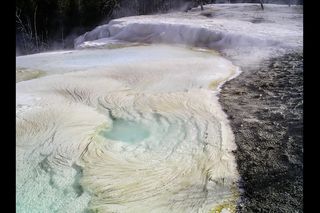Weird 'Fettucine' Rocks May Help Us Spot Life on Mars

Let's be very clear: No one is suggesting that Martians feast on pasta during a Red Planet all-you-can-eat buffet.
But if scientists find a type of rock on Mars that looks a bit like fettuccine, it could be a key sign that a certain type of bacteria once lived on Earth's next-door neighbor, researchers said in a new study. That hypothesis is based exclusively on observations made here on Earth; scientists have found neither this type of rock on the Red Planet nor any definitive proof of life on Mars. Nevertheless, it's an intriguing feature that scientists can look for as they seek to better understand the Red Planet.
"If we see the deposition of this kind of extensive filamentous rock on other planets, we would know it's a fingerprint of life," lead author Bruce Fouke, a geologist at the University of Illinois at Urbana-Champaign, said in a statement. "It's big and it's unique. No other rocks look like this. It would be definitive evidence of the presence of alien microbes."
Related: Why We Can't Depend on Robots to Find Life on Mars
Fouke and his colleagues studied bacteria taken from Yellowstone National Park's Mammoth Hot Springs, where the water is slightly acidic and reaches temperatures of over 150 degrees Fahrenheit (65 degrees Celsius).
Specifically, the scientists looked at a group of bacteria called Sulfurihydrogenibium, nicknamed sulfuri. These bacteria live in strings that can reach up to 4 inches (10 centimeters) long. Those strings then stick together in structures scientists call filamentous mats, which help the organisms stick together with their cohort in the flowing hot water.
But in the environment of the hot springs, these bacterial mats are "entombed" by rock, coated with crystals of a compound called calcium carbonate in the form of travertine. Each strand picks up a layer of rock about 0.2 inches (5 millimeters) thick every day.
Get the Space.com Newsletter
Breaking space news, the latest updates on rocket launches, skywatching events and more!
Fouke and his colleagues wanted to better understand these bacteria and the rock that builds up around them, so the researchers went fishing for mats of stringy bacteria. "They form tightly wound cables that wave like a flag that is fixed on one end," Fouke said. "These sulfuri cables look amazingly like fettuccine pasta, while further downstream, they look more like capellini pasta."
The team ran a whole host of tests on both the bacteria and the rock. The researchers analyzed the DNA sequences of the samples, so they could identify the precise species they were looking at. They also analyzed the proteins these bacteria were producing and how the organisms produce energy to feed themselves.

But the research wasn't just about the bacteria themselves; the scientists also wanted to understand the rock encasing the life-forms and how these organic and inorganic materials interacted within the hot spring's waters.
The researchers found clear fingerprints in the rock that pointed to the bacteria that shaped the material's formation. Those clues included morphological features, such as the string-like structure that remains after the bacteria die and the elliptical holes left behind by gases the bacteria release, as well as chemical features, like fatty acid molecules that remain locked in the rock.
That's why Fouke and his colleagues think the travertine could be such a valuable clue for scientists looking for signs of life on Mars; because the rock built itself around bacteria, it retains information about that bacteria.
And if you're wondering how the researchers collected the bacterial samples they studied in this project: They used sterilized pasta forks, naturally.
The research is described in a paper published April 30 in the journal Astrobiology.
- In the Search for Alien Life, 'Everyone Is an Astrobiologist'
- Ocean Moons, Promising Targets in Search for Life, Could Be Dead Inside
- The 6 Most Likely Places to Find Alien Life
Email Meghan Bartels at mbartels@space.com or follow her @meghanbartels. Follow us on Twitter @Spacedotcom and on Facebook.
Join our Space Forums to keep talking space on the latest missions, night sky and more! And if you have a news tip, correction or comment, let us know at: community@space.com.

Meghan is a senior writer at Space.com and has more than five years' experience as a science journalist based in New York City. She joined Space.com in July 2018, with previous writing published in outlets including Newsweek and Audubon. Meghan earned an MA in science journalism from New York University and a BA in classics from Georgetown University, and in her free time she enjoys reading and visiting museums. Follow her on Twitter at @meghanbartels.
